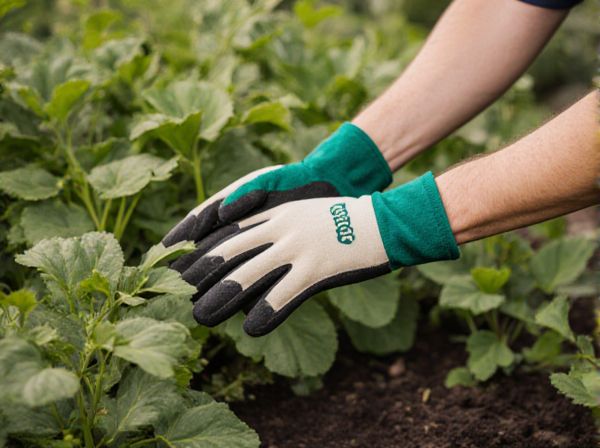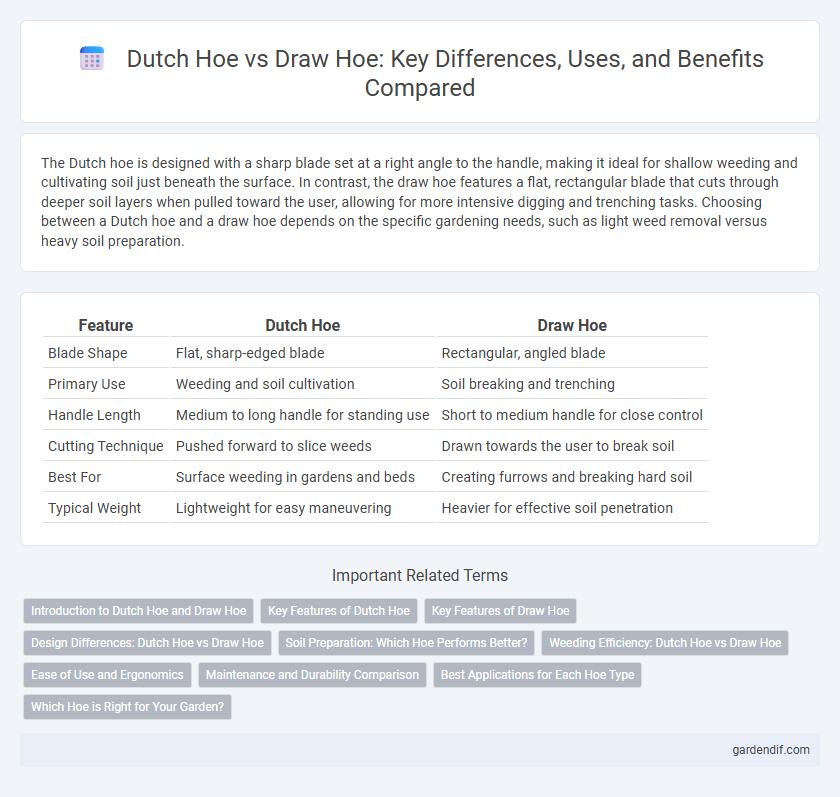
Dutch Hoe vs Draw Hoe Illustration
The Dutch hoe is designed with a sharp blade set at a right angle to the handle, making it ideal for shallow weeding and cultivating soil just beneath the surface. In contrast, the draw hoe features a flat, rectangular blade that cuts through deeper soil layers when pulled toward the user, allowing for more intensive digging and trenching tasks. Choosing between a Dutch hoe and a draw hoe depends on the specific gardening needs, such as light weed removal versus heavy soil preparation.
Table of Comparison
| Feature | Dutch Hoe | Draw Hoe |
|---|---|---|
| Blade Shape | Flat, sharp-edged blade | Rectangular, angled blade |
| Primary Use | Weeding and soil cultivation | Soil breaking and trenching |
| Handle Length | Medium to long handle for standing use | Short to medium handle for close control |
| Cutting Technique | Pushed forward to slice weeds | Drawn towards the user to break soil |
| Best For | Surface weeding in gardens and beds | Creating furrows and breaking hard soil |
| Typical Weight | Lightweight for easy maneuvering | Heavier for effective soil penetration |
Introduction to Dutch Hoe and Draw Hoe
Dutch hoes and draw hoes are essential gardening tools designed for soil cultivation and weed control. The Dutch hoe features a flat blade that cuts weeds just below the soil surface when pushed or pulled, making it efficient for shallow weeding in rows. In contrast, the draw hoe has a pointed, triangular blade used primarily for digging, chopping, and breaking up hard soil, ideal for initial soil preparation.
Key Features of Dutch Hoe
The Dutch hoe features a flat, sharp blade designed for efficient weeding by slicing just below the soil surface, minimizing soil disturbance and enhancing weed control. Its lightweight, ergonomic handle allows for precise, repetitive back-and-forth motions, making it ideal for shallow cultivation in garden beds. This tool excels in cutting young weeds quickly, promoting healthier plant growth by maintaining clean soil without uprooting beneficial plants.
Key Features of Draw Hoe
The Draw Hoe features a curved blade designed for efficient soil cultivation, allowing precise control in shallow digging and weeding tasks. Its ergonomic wooden handle provides enhanced leverage and comfort during prolonged use, optimizing user performance. Unlike the Dutch Hoe, the Draw Hoe excels in pulling motions, making it ideal for breaking up hard soil and trenching.
Design Differences: Dutch Hoe vs Draw Hoe
The Dutch Hoe features a broad, flat blade angled sharply for slicing weeds just below the soil surface, making it ideal for shallow cultivation and weed control. In contrast, the Draw Hoe has a narrower, more rectangular blade designed primarily for breaking up and moving soil with a pulling motion. These design differences influence their specific agricultural uses, with the Dutch Hoe excelling in precision weeding and the Draw Hoe better suited for soil preparation and trenching.
Soil Preparation: Which Hoe Performs Better?
The Dutch Hoe excels in soil preparation by efficiently slicing through weeds just below the surface, promoting aeration and minimal soil disturbance. In contrast, the Draw Hoe is ideal for breaking and turning compacted soil, making it suitable for initial ground preparation and creating planting rows. For precise weed control and surface aeration, the Dutch Hoe performs better, while the Draw Hoe is preferred for heavy-duty soil loosening.
Weeding Efficiency: Dutch Hoe vs Draw Hoe
The Dutch hoe features a sharp blade that cuts weeds just below the soil surface with a pushing motion, enabling fast and efficient weed removal in large garden areas. The draw hoe, with its flat blade and pulling action, excels in loosening soil while uprooting deeper, established weeds, making it ideal for intensive weeding in smaller plots. For optimum weeding efficiency, gardeners often select the Dutch hoe for broad, shallow weed control and the draw hoe for precise, deep weed extraction.
Ease of Use and Ergonomics
Dutch hoes feature a lightweight design and angled blade, enhancing ease of use by reducing wrist strain during soil cultivation. In contrast, draw hoes have a heavier, flat blade that demands more physical effort but offers greater control for precise weeding. Ergonomically, Dutch hoes are preferred for prolonged gardening tasks due to their user-friendly handle and reduced fatigue, while draw hoes suit intensive tilling requiring sturdy, direct force application.
Maintenance and Durability Comparison
Dutch hoes typically feature a solid, heavy-duty steel blade designed for rigorous soil cultivation, offering high durability with minimal maintenance beyond regular cleaning and occasional sharpening. Draw hoes, with their broader, flatter blades, require more frequent sharpening and rust prevention due to thinner metal construction but allow for easier blade replacement, which can enhance lifespan with proper care. Both tools benefit from consistent blade cleaning, drying, and oiling to prevent corrosion and maintain optimal performance over time.
Best Applications for Each Hoe Type
Dutch hoes excel at shallow cultivation, making them ideal for weeding between rows and aerating soil without damaging plant roots. Draw hoes are designed for deeper digging and breaking up hard-packed soil, suitable for preparing garden beds and trenching. Choosing the right hoe depends on whether precision weeding or heavy soil turning is required for optimal gardening efficiency.
Which Hoe is Right for Your Garden?
Dutch hoes feature a flat, sharp blade ideal for slicing through soil and weeds with precision, making them perfect for narrow garden beds and vegetable patches. Draw hoes have a sturdier, broader blade designed to break up hard soil and move larger amounts of earth, suitable for preparing garden rows and heavy-duty tasks. Choosing the right hoe depends on garden size and soil conditions, with Dutch hoes excelling in delicate weeding and draw hoes providing efficient soil cultivation.
Dutch Hoe vs Draw Hoe Infographic

 gardendif.com
gardendif.com